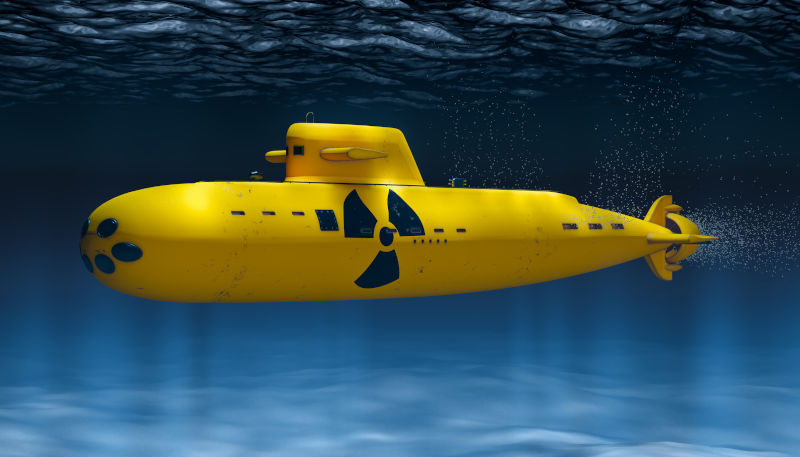How safe are nuclear powered submarines?
March 25, 2023
The acquisition of nuclear-propelled submarines has been enthusiastically embraced by Albanese, Dutton, most of their benches, and their collective military-industrial backing chorus. In considering where the submarines will be based, questions about radiation leaks and accidents have been shunted to a back burner.
The historical record on safety of such vessels should compel our government considerable pause, particularly in choosing such a congested harbour as Port Kembla as their home base.
The danger of radioactive leakage from marine nuclear cores has been a perennial concern of naval architects since the worlds first nuclear propelled ship, the Soviet ice breaker Lenin, left the slipway in 1959. It was powered by three nuclear reactors, at least two of which suffered coolant loss and suspected melt-downs during their lives, although Moscow never released all the details. Japans first nuclear-powered vessel, the cargo ship Mutsu, launched in 1977, also suffered radioactive leakages due to inadequate shielding of its Westinghouse-designed pressurised water reactor. At considerable expense, Mutsus reactor was replaced with a conventional diesel engine and the ship was re-named the Mirai.
Since the advent of nuclear propulsion on submarines, 14 Soviet era submarines have been recorded as suffering from reactor-related accidents. They included loss of coolant, breakdown of reactor protection systems, or damage during re-fuelling. It is extremely likely that British, French, Chinese, Indian and American submarines have suffered similar accidents, although apart from one case, these are closely guarded secrets. The exception is HMS Vanguard, one of Britains four Trident submarines, a nuclear-propelled and armed behemoth of nearly 16,000 tonnes. In March 2014, a breach was detected in Vanguards fuel cladding while the vessel was moored at the Devonport Royal Dockyard. This led to a leak of radiation in the vessels secondary-cooling system. The reactor core was replaced in 2015.
Collisions and sinkings are another matter. Since the invention of nuclear-powered submarines, at least nine have sunk, either through accident or because of system malfunctions including radiation leakages. Five were Soviet boats, three American. The Russian ones included Kursk which sank in April 2000 in the Barents Sea inside the Arctic Circle following an explosion in its torpedo room. American ones included the Attack submarine Thresher, lost with all 129 hands in April 1963, Scorpion, a Skipjack Attack submarine lost with 99 crew in May 1968, and Guitarro, a Sturgeon-class Attack submarine in May 1969. Each carried to its deep sea grave hundreds of kilograms of radioactive fuel, never to be recovered.
Following the demise of the Soviet Union, five Scandinavian and Baltic countries provided funds to enable the rusting hulls of 16 Soviet-era nuclear submarines to be towed from their berths at the Russian port of Gremikha to dismantling yards. At least one, K-159, didnt make it, but sank with 800 kilos of nuclear fuel on board in the Barents Sea. Is the accumulated environmental impact of such sunken nuclear reactors worse than Japans proposed release of millions of gallons of irradiated water into the Pacific Ocean from its Fukushima reactors? Perhaps so, but it has not been measured or compared.
Given this historical accumulation of real and potential disasters, what discussions have Australias naval authorities had with US and UK nuclear submarine builders and submarine commanders about nuclear accidents, either on Astute or Virginia-class boats? What guarantees can the Australian Navy extract from the United States Navy that the three to five pre-owned US Virginias we are to get have never had nuclear-accidents or radiation leaks? For that matter how many years of the 30-year life of the reactors will have already been expended when we get the boats? Will discounts be made to the eye-watering costs of the vessels?
Following these second-hand Virginias, we are supposed to get some sort of evolved British-designed Astute class boats, also at extravagant expense. The hulls will presumably be made at the Australian Shipbuilding Company at Osborne on the Port River in Adelaide, with reactors based on Westinghouse design and made under licence by Rolls Royce welded into them. Here again, hard questions will relate to reliability and safety. Another possibility, almost a certainty, is that by that time, underwater detection technology will have improved to such an extent that the undersea will be transparent, and foreign bodies such as the hulls of submarines, no matter how fast or silent, as well as their heat signatures, will be easily detected, easy prey for an as yet to be invented array of guided unmanned explosive devices.
